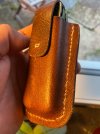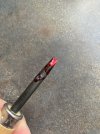Gary W. Graley
“Imagination is more important than knowledge"
Knifemaker / Craftsman / Service Provider
- Joined
- Mar 2, 1999
- Messages
- 27,234
Forgot to mention, that while I enjoy sheath making, for folders both belt carry and pocket slip, I would not fall under the title of Pro since I don’t do this for a living, there are many here that are Pro status for sure.Great tips, love your work. Interesting a pro like you are skipping the groove lines, ....
and on the groove cutting, back in the day when I use to make fixed blade sheaths, when I would sew up the belt loop, the area inside the sheath where the stitching is, I would dig grooves along the lines there so the stitching would be well below the leather level so when the knife was inserted it wouldn't rub against the threads and wear them down. The glue would keep things in place but better safe than sorry.
Here's a sheath I made for a friend a few years back, cross draw style. I used a piece of paper to figure out how to make the belt strap that wraps around the sheath so it would ride at the angle he wanted while still having the leading edge of the strap parallel with the opening. And I mounted a metal concho on the belt loop.
 crossdraw_welt by GaryWGraley, on Flickr
crossdraw_welt by GaryWGraley, on Flickr crossdraw_gluing by GaryWGraley, on Flickr
crossdraw_gluing by GaryWGraley, on Flickrwelt was layered and tapered down to the middle layer of the welt, needed to do this since the handle and guard were quite thick
 crossdraw_cam by GaryWGraley, on Flickr
crossdraw_cam by GaryWGraley, on Flickrthe arch of the welt provides a cam action that the guard rides along on until it drops into the end section and stops at the cut off point, so the knife snaps into place securely.
 crossdraw_cam_stop by GaryWGraley, on Flickr
crossdraw_cam_stop by GaryWGraley, on Flickr crossdraw_out by GaryWGraley, on Flickr
crossdraw_out by GaryWGraley, on Flickr crossdraw_angle by GaryWGraley, on Flickr
crossdraw_angle by GaryWGraley, on Flickr crossdraw_done_ by GaryWGraley, on Flickr
crossdraw_done_ by GaryWGraley, on Flickr crossdraw_done by GaryWGraley, on Flickr
crossdraw_done by GaryWGraley, on FlickrIt is tricky to get that cam just right, as I have to keep shaping the curve so it allows the knife to go into the sheath but still retain it once it snaps into place.
I don't take on fixed blade sheaths but occasionally I'll get snagged into making one, but it just isn't something that I like doing for a few reasons. So I leave the fixed blade sheath work to those guys that excel in that area and they are very good at it!
G2
Last edited:







